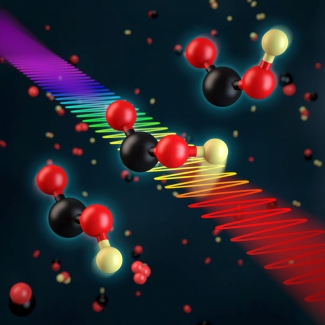The reaction, at first glance, seems simple. Combustion engines, such as those in your car, form carbon monoxide (CO). Sunlight converts atmospheric water into a highly reactive hydroxyl radical (OH). And when CO and OH meet, one byproduct is carbon dioxide (CO2) – a main contributor to air pollution and climate change.
But it’s more complicated than that. Before CO2 is formed, a short-lived, intermediate molecule, called the hydrocarboxyl radical (HOCO), is formed. The existence of HOCO was first proposed over 40 years ago, but the unstable nature of the molecule made it difficult, nearly impossible, to observe. The Ye group of JILA, however, has been closing in on the impossible.
The deuterated version of HOCO, called DOCO, was observed by Bryce J. Bjork, Thinh Q. Bui, Jun Ye, and their collaborators in 2016. Deuteration, or substituting a heavier version of the hydrogen atom, called deuterium, reduced signal contamination from the atmospheric water in their system.
Yet their understanding of the reaction was incomplete. The version of DOCO that the Ye group observed did not dissociate into carbon dioxide. “There were a lot of missing details in the reaction pathway” said Thinh Bui, a postdoctoral researcher in the Ye group.
In their new paper, published in Science Advances, every step of the reaction, starting from the reactants, OD and CO, all the way to the final product of CO2, and every intermediate in between, is finally accounted for.
Specifically, the group detected the two variations of DOCO, trans-DOCO and cis-DOCO. The cis- and trans- prefixes denote different geometric isomers, or arrangements of the atoms within the molecule. The two isomers differ by only a single bond rotation, with cis-DOCO resembling a boat, and trans-DOCO resembling a chair.
Cis-DOCO is the more elusive of the two isomers because it is more energetic. Like a child running around, the high energy cis-DOCO rotates, vibrates, and generally evades detection. Remove this high energy with a molecular collision and the cis-DOCO calms down. Let cis-DOCO run around however, and something more interesting happens: cis-DOCO will dissociate into deuterium and CO2, a trick that the calmer trans-DOCO cannot do.
The original work by the Ye group identified only the trans-DOCO variation. To identify cis-DOCO, the group had to wade through heaps of overlapping molecule signals.



 The Physics Frontiers Centers (PFC) program supports university-based centers and institutes where the collective efforts of a larger group of individuals can enable transformational advances in the most promising research areas. The program is designed to foster major breakthroughs at the intellectual frontiers of physics by providing needed resources such as combinations of talents, skills, disciplines, and/or specialized infrastructure, not usually available to individual investigators or small groups, in an environment in which the collective efforts of the larger group can be shown to be seminal to promoting significant progress in the science and the education of students. PFCs also include creative, substantive activities aimed at enhancing education, broadening participation of traditionally underrepresented groups, and outreach to the scientific community and general public.
The Physics Frontiers Centers (PFC) program supports university-based centers and institutes where the collective efforts of a larger group of individuals can enable transformational advances in the most promising research areas. The program is designed to foster major breakthroughs at the intellectual frontiers of physics by providing needed resources such as combinations of talents, skills, disciplines, and/or specialized infrastructure, not usually available to individual investigators or small groups, in an environment in which the collective efforts of the larger group can be shown to be seminal to promoting significant progress in the science and the education of students. PFCs also include creative, substantive activities aimed at enhancing education, broadening participation of traditionally underrepresented groups, and outreach to the scientific community and general public.